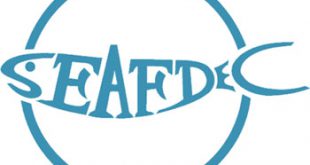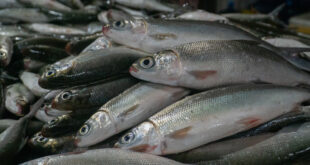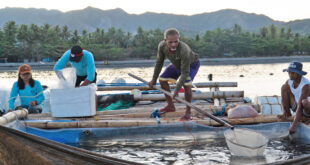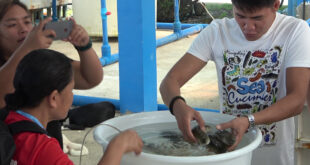 Technology Description
Technology Description
The farming of the seaweed Kappaphycus can be a low-cost venture and a profitable one, with the right site. The technology can use family labor in either fixed off-bottom (“parasdas”) or single raft long-line culture. The more line modules, the more investment and care are needed. After tying seaweed plantlets or “seedlings” to the ropes, and the ropes staked to the sea bed by bamboo or tied to floating rafts staked to the sea bed, seaweed farming needs no more inputs. There is periodic visitation, two to three times a week, to remove undesirable algae, barnacles, and attached sediments; to re-tie loose or fallen seaweed; to tighten lines; and to check for signs of “ice-ice” disease. Seaweed culture can last 45-60 days.
| Technology profile: | |
| (1) Get and select good quality seedlings; these are brittle, shiny and young branches with sharp pointed tips, no traces of grazing or whitened thallus (sign of beginning “ice-ice” disease), and 100-150 grams.
(2) For fixed off-bottom culture ~ While on land, tie seaweed seedlings 15-20 cm apart to the cultivation rope 10-20 m long with soft plastic string (commonly called “tie-tie”). Carry the ropes to the site at the lowest tide and tie both ends to stakes already placed 1-meter apart on the seabed. For single raft long-line ~ Tie seedlings as above but anchor ropes to a bamboo raft. A raft unit consists of four bamboos in a square arrangement as support with two ends tied in turn to anchor lines which are staked to the seabed. A longer raft long-line (50-70 m long) can be made;floats are regularly spaced in this instance to add buoyancy to the raft.In deeper waters (5-10 m), the hanging long-line may be best; less bamboo support is used but a good concrete block anchor is necessary. (3) Visit the farm two to three times a week. Remove undesirable algae, barnacles, or attached sediments. Re-tie loose or fallen seaweed. Check and tighten loose rope or stake. Check for signs of diseases; totally harvest crops immediately if present. Use new set of seedlings, change farming site / method, and use lower stocking density. (4) Harvest in 45-60 days. Seaweed can be sold wet or dry to processors. Dried seaweed brings more income if it is clean and with moisture content of 35-39%. It is best to keep harvested seaweeds off the ground (remember that the carrageenan is bound for products for human consumption). Use a layer of mat, fish net, or coconut leaves and constantly turn seaweeds to accelerate drying; or dry seaweeds in a platform or hangings lines. Sun-dry for 2-3 days. (5) Tie the seaweed in bales, then store in a clean, cool, dry and well-ventilated place while awaiting buyers. |
|
References:
Hurtado-Ponce AQ. 1992. Cage culture of Kappaphycus alvarezii var. tambalang (Gigartinales, Rhodophyceae). Journal of Applied Phycology 4:311-313
Hurtado-Ponce AQ. 1995. Carrageenan properties and proximate composition of three morphotypes of Kappaphycus alvarezii Doty (Gigartinales, Rhodophyta) grown at two depths. Botanica Marina 38:215-219
Hurtado AQ, Agbayani RF. 2002. Deep-sea farming of Kappaphycus using the multiple raft, long-line method. Botanica Marina 45:438-444
Hurtado AQ, Agbayani RF. 2000. The farming of the seaweed Kappaphycus. Aquaculture Extension Manual No. 32, SEAFDEC Aquaculture Department, Tigbauan, Iloilo. 25 p
Hurtado-Ponce AQ, Luhan MaRJ, Guanzon NG Jr. 2006. Seaweeds of Panay (2nd Ed.). SEAFDEC Aquaculture Department, Tigbauan, Iloilo. 50 p
Hurtado-Ponce AQ, Agbayani RF, Chavoso EAJ. 1996. Economics of cultivating Kappaphycus alvarezii using the fixed-bottom line and hanging-long line methods in Panagatan Cays, Caluya, Antique, Philippines. Journal of Applied Phycology 8:105-109
Hurtado AQ, Agbayani RF, Sanares R, de Castro-Mallare MTR. 2001. The seasonality and economic feasibility of cultivating Kappaphycus alvarezii in Panagatan Cays, Caluya, Antique, Philippines. Aquaculture 199:295-310
Peñaflorida VD, Golez NV. 1996. Use of seaweed meals from Kappaphycus alvarezii and Gracilaria heteroclada as binders in diets for juvenile shrimp Penaeus monodon. Aquaculture 143:393-401
Samonte GPB, Hurtado-Ponce AQ, Caturao RD. 1993. Economic analysis of bottom line and raft monoline culture of Kappaphycus alvarezii var. tambalang in Western Visayas, Philippines. Aquaculture 110:1-11
Seaweed culture, 2000, a 3-fold flyer downloadable from the SEAFDEC/AQD website www.seafdec.org.ph/publications_downloadable.html
 SEAFDEC/AQD Southeast Asian Fisheries Development Center | Aquaculture Department
SEAFDEC/AQD Southeast Asian Fisheries Development Center | Aquaculture Department



